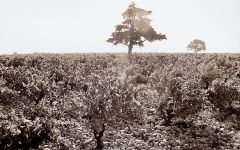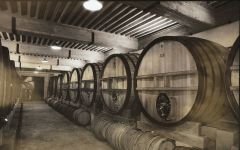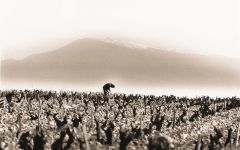Domaine du Vieux Telegraphe Chateauneuf-du-Pape La Crau 2018
-
Robert
Parker -
Jeb
Dunnuck -
Wine
Spectator -
James
Suckling -
Wine &
Spirits



Product Details
Your Rating
Somm Note
Winemaker Notes
The 2018 Domaine du Vieux Telegraphe Chateauneuf-du-Pape La Crau is a classic red Châteauneuf-du-Pape, very fine and elegant. The best vintages will age for 25 years and more.
Professional Ratings
-
Robert Parker's Wine Advocate
The final blend of the 2018 Chateauneuf du Pape La Crau will include 60% to 65% Grenache, 15% each Mourvèdre and Syrah, with the remainder Cinsault. Boasting complex scents of roses, black tea, raspberries and cherries on the nose, it follows that up with a full-bodied palate that's silky and airy in texture yet flavorful and tremendously long on the finish. It fits perfectly with the Brunier's stated goal of pursuing elegance.
Barrel Sample: 94-96
-
Jeb Dunnuck
The grand vin is the 2018 Châteauneuf Du Pape. It's an elegant version of this cuvée, offering beautiful blueberry, raspberry, crushed violet, graphite, and crushed rock-like minerality. Rich, medium to full-bodied, and balanced, it’s polished and seamless, yet has plenty of tannins as well as richness, and is going to evolve beautifully.
Barrel Sample: 93-95
-
Wine Spectator
A nice throwback style, with a range of dried lavender and rosemary notes peeking out from a cedar-framed core of mulled cherry, blood orange and plum fruit. Features warm stone, licorice root and tobacco leaf accents that fill in through the energetic finish. A wine that's very confident in its terroir. Best from 2024.
-
James Suckling
The finished blend that is now aging another year in 60 hectoliter barrels, this has a very fleshy, round, rich and smooth-honed palate that has such completeness already. The raspberries and red plums are stunning here. The tannins are there and very open-knit and there’s a super sapid feel to the finish. The 15% mourvedre does much of the heavy lifting here. It shapes the finish and drags it deep. Around one-third from crushed grapes with stems. Drinkable on release, but best from 2024.
Barrel Sample: 94-95 -
Wine & Spirits
The Bruniers have specialized in wines from La Crau, a lieu-dit in the northeast of the appellation, since 1898, when Hippolyte Brunier began building a name for his wines. The high elevation and the limestone-rich, galetcovered soils make for some of the appellation’s most elegant wines, their rich red fruit balanced by brisk acidity. The 2018 channels a bright, fresh feeling right from the start, with lots of floral spice moderating the sweet red-cherry flavor. There’s plenty of depth there, too, with earth notes that bring to mind roasted game, as well as forest floor and fresh button mushrooms. But it’s the brightness and freshness that make this so compelling, and so readily drinkable, especially if there are some lamb chops around.
Other Vintages
2021- Vinous
-
Wine
Spectator -
Robert
Parker -
Wine &
Spirits
-
James
Suckling - Decanter
-
Robert
Parker - Vinous
-
Wine
Spectator
-
James
Suckling -
Robert
Parker -
Jeb
Dunnuck -
Wine
Spectator
-
James
Suckling -
Jeb
Dunnuck -
Wine
Spectator -
Robert
Parker
-
James
Suckling -
Jeb
Dunnuck -
Robert
Parker -
International
Wine Cellar - Decanter
-
James
Suckling -
Wine
Spectator -
Robert
Parker - Decanter
-
Wine
Spectator
-
Robert
Parker -
Wine
Spectator
-
Robert
Parker -
Wine
Spectator
-
Wine &
Spirits -
Wine
Spectator -
Robert
Parker
-
Robert
Parker -
Wine
Spectator -
Wine &
Spirits
-
Wine
Spectator -
Robert
Parker
-
Wine
Spectator -
Robert
Parker
-
Robert
Parker -
Wine
Spectator
-
Wine
Spectator -
Robert
Parker
-
Wine
Spectator -
Robert
Parker
-
Wine
Spectator
-
Wine &
Spirits -
Wine
Spectator -
Wine
Enthusiast
-
Robert
Parker
-
Wine
Spectator
-
Wine
Spectator





One cannot think of Chateauneuf-du-Pape, the most celebrated cru of the Southern Rhône, without thinking of Domaine du Vieux Télégraphe. The Brunier family is legendary in its own right, having been rooted to the enigmatic plateau known as “La Crau” for over one hundred years. The wines of Vieux Télégraphe evoke the concept of terroir in its purest form: they reflect their dramatic climate, the rough terrain that defines the soil, their full sun exposure at a higher altitude, the typicity of the varietals with an emphasis on Grenache, and of course, the influence of their caretakers, the Brunier family. For many, La Crau is Chateauneuf-du-Pape’s grandest cru.
The AOC for Chateauneuf-du-Pape is in the Rhone Valley stretching from Orange to Avignon. Domaine Vieux Telegraphe was founded in 1895, and takes it name Vieux Telegraphe (Old Telegraph) from a rocky plateau of the Domaine where in 1792 Me. Chappe, the inventor of the optical telegraph, installed a relay tower.

With bold fruit flavors and accents of sweet spice, Grenache, Syrah and Mourvèdre form the base of the classic Rhône Red Blend, while Carignan, Cinsault and Counoise often come in to play. Though they originated from France’s southern Rhône Valley, with some creative interpretation, Rhône blends have also become popular in other countries. Somm Secret—Putting their own local spin on the Rhône Red Blend, those from Priorat often include Merlot and Cabernet Sauvignon. In California, it is not uncommon to see Petite Sirah make an appearance.

Famous for its full-bodied, seductive and spicy reds with flavor and aroma characteristics reminiscent of black cherry, baked raspberry, garrigue, olive tapenade, lavender and baking spice, Châteauneuf-du-Pape is the leading sub-appellation of the southern Rhône River Valley. Large pebbles resembling river rocks, called "galets" in French, dominate most of the terrain. The stones hold heat and reflect it back up to the low-lying gobelet-trained vines. Though the galets are typical, they are not prominent in every vineyard. Chateau Rayas is the most obvious deviation with very sandy soil.
According to law, eighteen grape varieties are allowed in Châteauneuf-du-Pape and most wines are blends of some mix of these. For reds, Grenache is the star player with Mourvedre and Syrah coming typically second. Others used include Cinsault, Counoise and occasionally Muscardin, Vaccarèse, Picquepoul Noir and Terret Noir.
Only about 6-7% of wine from Châteauneuf-du-Pape is white wine. Blends and single-varietal bottlings are typically based on the soft and floral Grenache Blanc but Clairette, Bourboulenc and Roussanne are grown with some significance.
The wine of Chateauneuf-du-Pape takes its name from the relocation of the papal court to Avignon. The lore says that after moving in 1309, Pope Clément V (after whom Chateau Pape-Clément in Pessac-Léognan is named) ordered that vines were planted. But it was actually his successor, John XXII, who established the vineyards. The name however, Chateauneuf-du-Pape, translated as "the pope's new castle," didn’t really stick until the 19th century.
